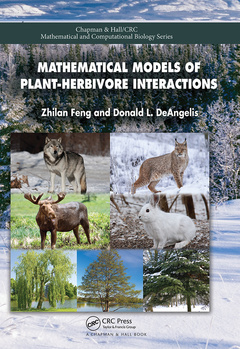Mathematical Models of Plant-Herbivore Interactions Chapman & Hall/CRC Mathematical Biology Series
Auteurs : Feng Zhilan, DeAngelis Donald

Mathematical Models of Plant-Herbivore Interactions addresses mathematical models in the study of practical questions in ecology, particularly factors that affect herbivory, including plant defense, herbivore natural enemies, and adaptive herbivory, as well as the effects of these on plant community dynamics.
The result of extensive research on the use of mathematical modeling to investigate the effects of plant defenses on plant-herbivore dynamics, this book describes a toxin-determined functional response model (TDFRM) that helps explains field observations of these interactions.
This book is intended for graduate students and researchers interested in mathematical biology and ecology.
Part I Basic Theory and Simple Models. Introduction. Predator-prey interactions. Overview of some results of plant-herbivore models. Models with Toxin-Determined Functional Response. Part II Applications. Plant quality and plant defenses: Parallels and differences. Herbivore strategies: the role of plant quality and defenses. Plant toxins, Food Chains, and Ecosystems. Fire, Herbivory, Tree Chemical Defense, and Spatial Pattersn in the Boreal Forest. Example of Mathematica Notebooks.
Zhilan Feng is a Professor of Mathematics at Purdue University. She is an editor for Journal of Theoretical Biology, Mathematical Biosciences, Mathematical Biosciences and Engineering, and SIAM Journal on Applied Mathematics.
Donald L. DeAngelis is a Senior Scientist with the US U. S. Geological Survey and Adjunct Professor at the University of Miami. He is subject editor for Ecosystems and Mathematical Biosciences.
Date de parution : 03-2021
17.8x25.4 cm
Date de parution : 08-2017
17.8x25.4 cm
Thèmes de Mathematical Models of Plant-Herbivore Interactions :
Mots-clés :
Snowshoe Hare; Interior Equilibrium Point; ecology; Unique Interior Equilibrium; mathematical ecology; Plant Herbivore Interactions; ecological resource management; Loss Rate Coefficient; population dynamics; Twig Biomass; mathematical biology; Moose Habitat; theoretical biology; Interior Equilibrium; Donald L; DeAngelis; Moose Densities; Hopf Bifurcation; Deciduous Cell; Inducible Defenses; Traveling Wave Solution; Equilibrium Point; North American Boreal Forest; Wolf Control; Plant Herbivore System; Predator Control; Boreal North America; Herbivore Biomass; Resin Glands; Hare Cycle; Browsing Mammals; Douglas Fir Tussock Moth; Hunting Rate



